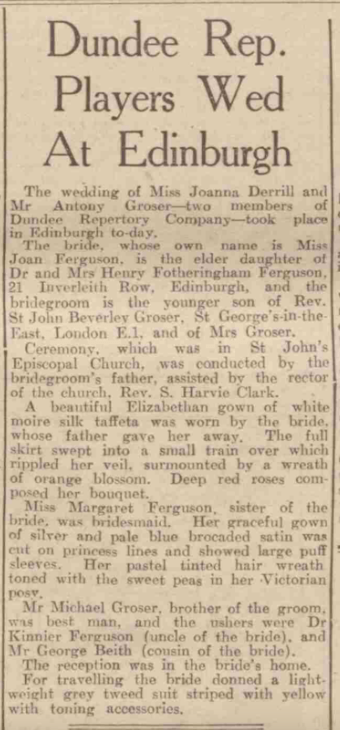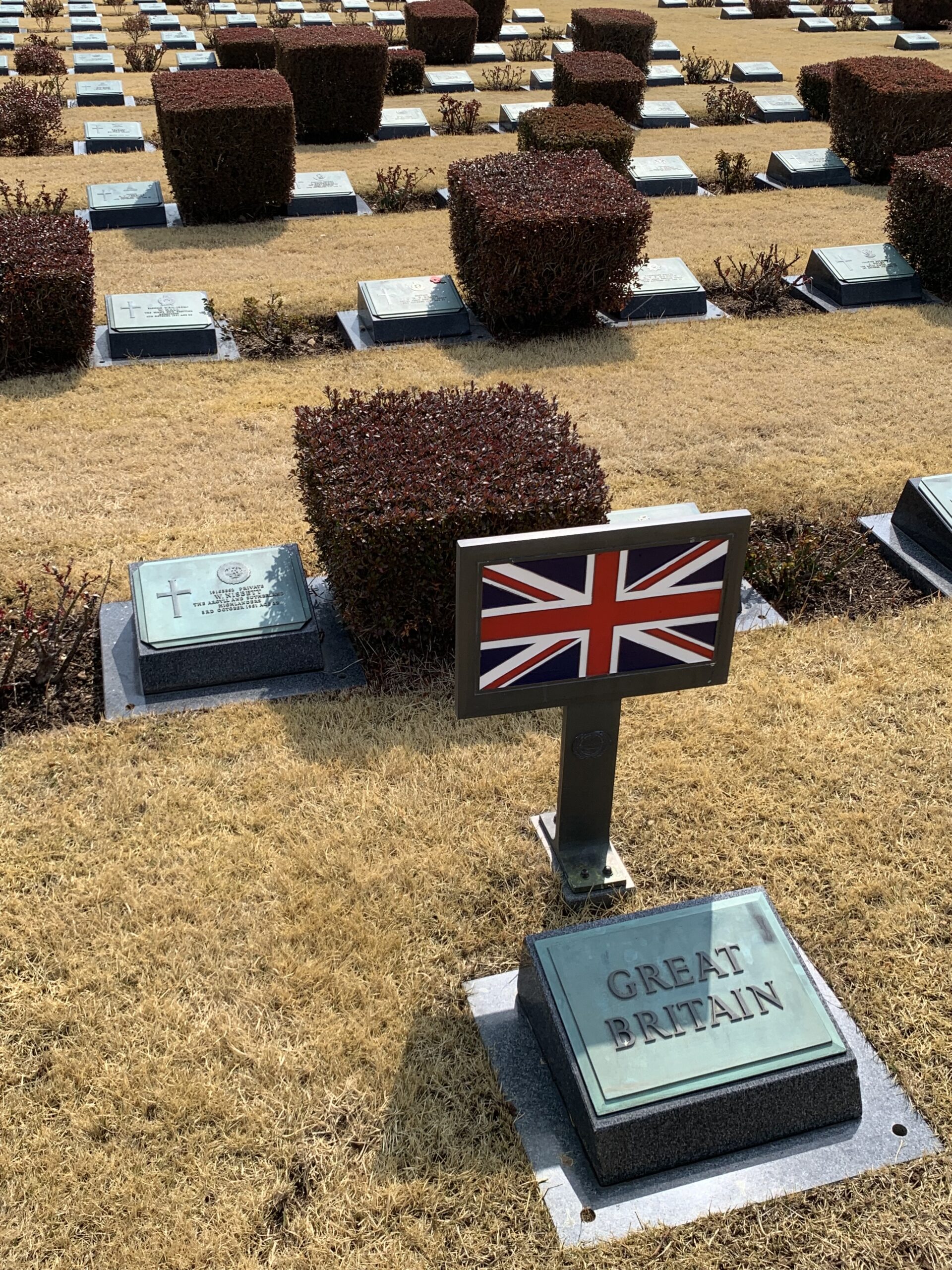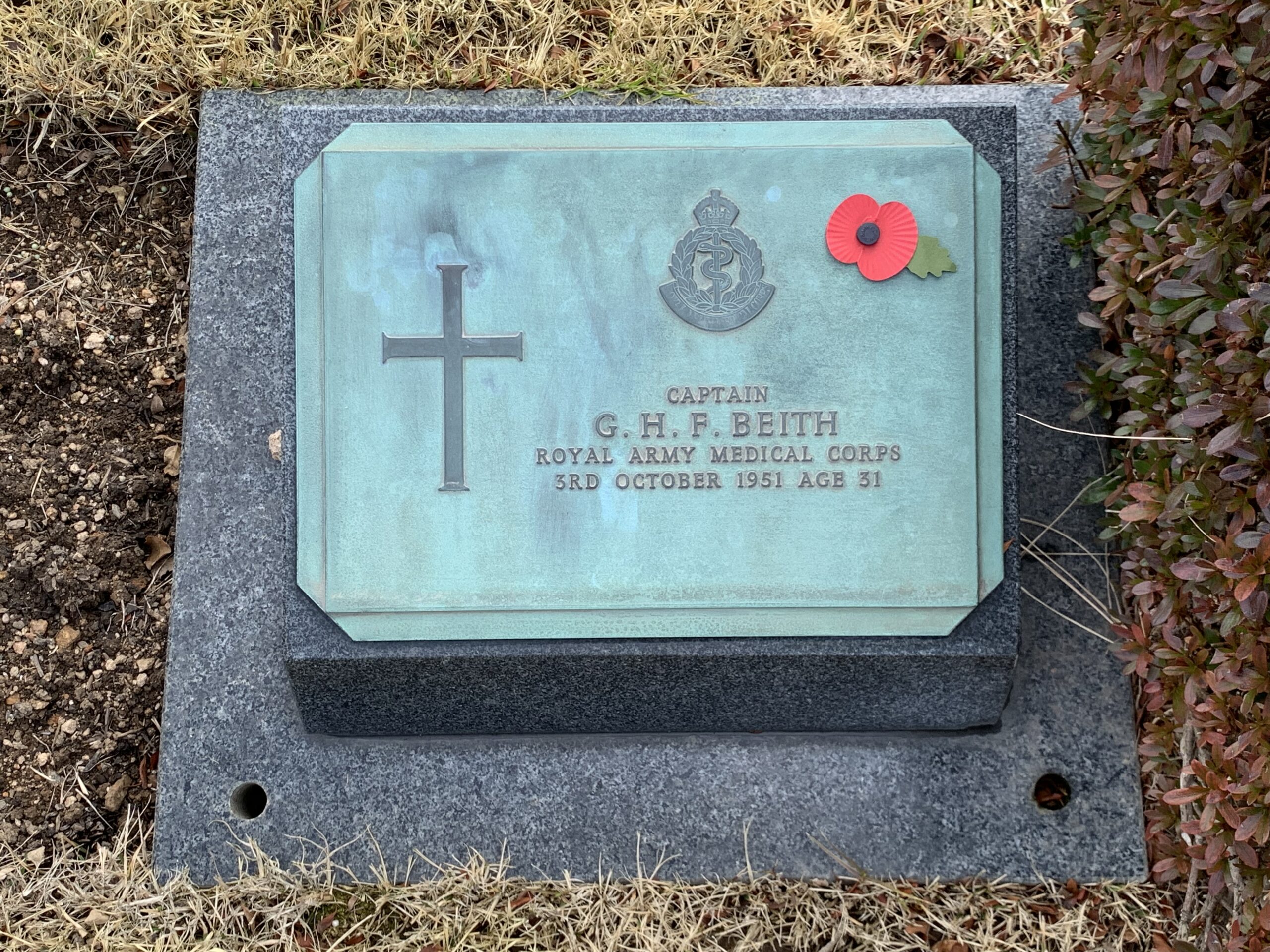A chance discovery on the British Newspaper Archive back in May 2020 has taken me on a journey researching the life of a first cousin once removed in the hope that his closer family will find out how he is commemorated.
The article in question was a report in the Dundee Evening Telegraph of 20 August 1945 of the marriage of my maternal aunt Joanna Ferguson and Mr Antony Groser. They were both members of Dundee Rep and Derrill was Aunty Joan’s stage name.
The report was fascinating in its own right with a lot of detail about what the bride and bridesmaid (my Mum) wore which seemed very sumptuous considering there was war time rationing but the fact that jumped out at me was the mention of one of the ushers, Mr George Beith, ‘cousin of the bride’.
This wasn’t a name I had come across before so I quickly went off to see what I could find out about him. Not much at first and sadly no-one left to ask. Born in 1920 in Pontypridd. His mother was Mary Gibson Ferguson (1894 to 1971) who was sister to my maternal grandfather – Henry Fotheringham Ferguson. George died in 1951 in Korea.
Fast forward to July 2021 and I was contacted on Ancestry by Martin Uden who was researching the lives of British servicemen buried at the United Nations Memorial Cemetery in Busan. In the course of this research he wanted to make relatives of Korean war veterans aware of various programmes available to them including how next of kin can apply to receive an Elizabeth Cross and a Korean Ambassador for Peace Medal.
As I didn’t think that I was next of kin this prompted me to do a bit more research to see if he had children or grandchildren. I had no success at that point apart from discovering that he married Eileen Savage on the 3 September 1947 in West Bridgford. A report in the Nottingham Journal the following day described how nurses from Nottingham General Hospital formed a guard of honour at the wedding. George had previously been a casualty officer at the hospital and Eileen was a nurse there.
Fast forward again to early 2024 when Martin Uden alerted me to details of a talk he was doing at the National Army Museum about his research into the men buried at Busan. I wasn’t able to attend in person but watched it online last week. This gave more details about how the project came about and has spurred me into action again.
You can watch the talk here British Servicemen in the Korean War with Martin Uden
Stephanie Hwang, Assistant Director of Public Relations at the UNMCK Office has kindly sent me the following photos of the location of Captain Beith’s grave which she took for me today.
360 degree tour showing the location of Captain Beith’s grave
A quick search on the Cemetery’s website brings up details of Captain Beith’s grave which includes a link to download his burial record which describes in just three terrible words how he died: ‘Wound, Missile, Head’.
This also includes fascinating information such as the colour of his hair: brown and the state of his teeth – which included one silver and one gold filling and one gold and one porcelain crown.
Captain Beith was a doctor in the RAMC (Royal Army Medical Corps) and was serving with the 8th Hussars when he lost his life on 3 October 1951.
RAMC journals online were a source of much information including the circumstances of his death. I have added in square brackets what the less obvious abbreviations stand for.
RAMC Journal Volumes 96-97, page 504 : “It falls to our sad lot to record the death of another R.M.O. of this Regiment [the 8th Hussars]. Captain G H F Beith was killed in action in Korea on October 3, 1951. Shortly after joining the RAMC in 1947 he was appointed to a short service commission and in August of 1949 he embarked for Hong Kong with 18 Field Ambulance. He retired from the Army shortly after his return to the UK in May 1950. In September 1950 he was recalled from RARO [Regular Army Reserve of Officers] and joined 29 General Hospital, with which he embarked for Japan in November 1950. After a period of service with 29 General Hospital he was posted to the 8th Hussars and served with them until his untimely death.”
RAMC Journal Volumes 98-99, page 51: “Unfortunately amongst those [60] killed [during Operation Commando] was Capt. Beith RAMC, the RMO to 8 Hussars, who was known to many of you when he served in Hong Kong in 1949/50. He was killed by mortar fire at his R.A.P. [regimental aid post] then sited close by the C.C.P. [casualty collection point] of the 60 Indian Fd. Amb.”
After publishing this blog post I then found an obituary on the website for the Museum of the Queen’s Royal Hussars which had some very complimentary things to say about Captain Beith:
“After our first Medical Officer Capt Patchett, was captured, it might well have been considered difficult to find another who fitted into the 8th Hussars so well. But after George Beith had served with us for a few weeks it became abundantly apparent that he had all the attributes that endear a Medical Officer to all ranks.
Professionally he was excellent, and his cheerful, but strict method of dealing with both officers and men was responsible for preserving the excellent health of the regiment under trying conditions.
Although George Beith had been with us for such a short time, his death by a chance shell more than ever brought home to everybody how much a friend of the 8th Hussars he had become.”
I then had to stop myself doing any more research into his life with the RAMC and to concentrate on the matter in hand.
After some intense research using the 1939 Register, the British Newspaper Archive, the General Register Office and further online searches I have now identified three descendants of George Beith and the next step is to try to make contact with them to pass on what I have found and also to make them aware of the programme for relatives of war veterans. I hope I can meet them too.



0 Comments